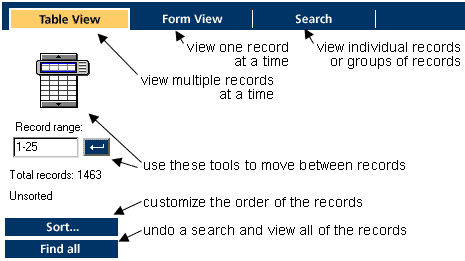SABE Living Collections Database
Using the database
The database includes tools along the top and left side of the page.

- TABLE VIEW contains the raw data in spreadsheet format, allowing you
to view multiple records at a time. - FORM VIEW displays the information for each individual record on a
separate page. - SEARCH allows you to extract individual records or groups of records
from the database. You may search by any of the 6 different fields,
either singly or in combination. - SORT (on the left side of the page) allows you to customize the order
of the records. They can be sorted by COLLECTION TYPE, COLLECTION NUMBER,
INSTITUTION, LOCATION #, and TAXON.
Examples of searches
- 1. To generate a core list of only the SABE germplasm that was brought back, input ‘germplasm collection’ under INSTITUTION and ‘SABE’ under COLLECTION TYPE. The result will be the 621 records, which can then be organized (SORTED) by collection number, taxon, location etc., as mentioned above.
- To find out which institutions have Sorbus yuana, type ‘Sorbus yuana’ in the TAXON field.
- To find out which plants were collected at location 44, type ‘44’ in to the LOCATION # field.
- To find out which collections are being maintained at the Arnold Arboretum, type ‘Arnold Arboretum’ or simply ‘Arnold’ in the INSTITUTION field.
Database Field Definitions
Each record contains information stored in six different fields: TAXON,
COLLECTION TYPE, COLLECTION NUMBER, INSTITUTION, LOCATION #, and LOCATION
DESCRIPTION.
- TAXON refers to the taxonomic identity of each collection, including recent changes in nomenclature or identity (i.e., following verification).
- COLLECTION TYPE refers to the three collection designations: those of the formal SABE, and those which were supplementary and tracked by the acronyms SAS and TRD for the collectors Stephen A. Spongberg and Ted R. Dudley, respectively.
- COLLECTION NUMBER is the specific number that each collection was assigned in the field, and are organized within the COLLECTION TYPE (e.g., SABE 1555 is Sorbus yuana while Heptacodium miconioides is SAS 10).
- INSTITUTION refers to the institution where living germplasm is presently located and grown. We also have referenced the initial germplasm collections under this field, under ‘germplasm collection’ instead of a specific institution.
- LOCATION # refers to the specific location in the field where the collection was made.
- LOCATION DESCRIPTION provides additional information for each LOCATION #, including habitat and geographic data.
